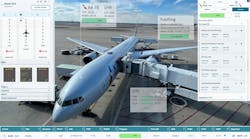Revolutionary. Transformative. Game changer. These are just a few descriptors people have attached to 5G, the next generation of wireless that will succeed 4G. The new standard is set to vastly improve connectivity between people and things. It dominates press headlines and takes center stage at nearly every tech conference—all while causing a world of confusion among business pros and consumers alike. Many questions remain. What really is 5G? When is it arriving? And what does that mean for airports?
I’m excited to address these questions and more on an upcoming Airport Business webinar on February 12 alongside Mark Duebner, director of aviation for the City of Dallas Department of Aviation. Here’s a sneak peek of what we’ll discuss.
· Continued 5G buzz in 2019.
Last year we got a taste of 5G, but 2019 will spur even more wireless innovation. We’ll see advancements across 5G chips, devices, operator networks and trials as the wireless industry readies for larger deployments in 2020.
· 5G’s impact on indoor wireless.
5G specifications address densely populated areas, which directly applies to many in-building use cases. Higher throughput, lower latency, larger bandwidths and bringing radios closer to the edge via smaller cells are the basics of 5G connectivity. As 5G standards evolve, they will address in-building connectivity challenges at airports and other large venues.
· Connected era of converged, neutral host networks.
Powering a new generation of 5G connectivity requires access to more spectrum. Beyond the 5G standard, technologies like Wi-Fi 6, CBRS and mmWave will facilitate a broad range of connected use cases. Airports should consider neutral host business models to take advantage of all available spectrum—licensed, unlicensed and shared.
· Lessons learned from a private LTE deployment.
Boingo recently worked with Mr. Duebner and Dallas Love Field Airport (DAL) to launch a private LTE cellular network on the 3.5 GHz CBRS band. The deployment is a pivotal step forward as CBRS will help accommodate connectivity in the 5G era. The webinar will cover lessons learned from the trial and what airports need to know about private LTE.
· Nobody has all the answers.
It’s an exciting time in wireless, but many 5G developments are still underway. As we navigate the future of wireless, collaboration between venues, wireless partners and carriers will be key to solve the complexities brought on by next generation networks.
Looking forward to joining the airport community for this informative webinar. Learn more or register by clicking here.
Doug Lodder is senior vice president of business development at Boingo Wireless (NASDAQ: WIFI). He is responsible for Boingo’s DAS, offload and wholesale businesses, where he oversees the strategy and development of Wi-Fi, DAS and small cell networks. Lodder leads the company’s venue partnerships and monetization strategies.
Lodder holds an MBA from the University of Southern California’s Marshall School of Business and an undergraduate degree from San Diego State University.
###

![Logo Notag Hex[1]x100 Logo Notag Hex[1]x100](https://img.aviationpros.com/files/base/cygnus/cavc/image/2020/10/logo_notag_hex_1_x100.5f9c63c6d8cae.png?auto=format,compress&fit=fill&pad=5&fill-color=white&q=45&h=139&height=139&w=250&width=250)


